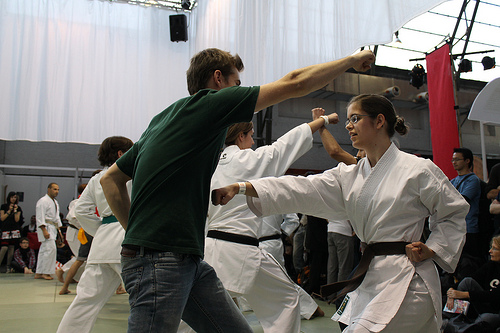
Karate is One of The Most Popular Martial Arts in the World
Karate is a broad church; Shotokan Karate, with its very deep stances and large movements, is a different animal from a knockdown style like Kyokushinkai, for instance. What you'll find in almost any Karate school is an emphasis on 'spirit' - fighting spirit, what we might call 'heart' or 'grit' - and often on clean technique achieved by high numbers of identical repetitions. Almost all Karate schools will train in the Gi, a suit of white 'pyjamas' that actually is based on the underwear layer of traditional oriental clothes. Karate comes from Chinese martial arts, and the name is made of characters meaning 'China Hand,' or 'Chinese Boxing;' it was changed to 'Empty Hand' - referring to the Zen buddhist concept of the creative void - in honour of the 'Father of Karate,' Funakoshi Sensei.
- Important notification about information and brand names used in this slideshow!
- Photo courtesy of elPadawan by Flickr : www.flickr.com/photos/elpadawan/8112338563/
- en.wikipedia.org/wiki/Self-defense
- http://thesegoto11.wordpress.com/2008/12/02/top-eleven-best-self-defence-martial-arts/
- http://listverse.com/2010/05/15/top-10-martial-arts-for-self-defense/
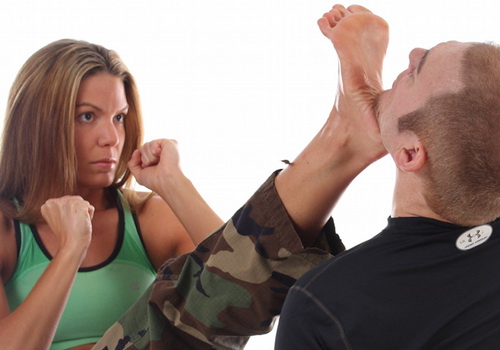
Kickboxing Comes From Boxing and Karate to Create a New Sport
Kickboxing was developed in the 1970s in the USA out of full contact Karate. At its root it is Krate kicks with boxing punches, and footwork developed from both systems. Kickboxing includes some sports where kicking is not allowed below the waist, and confusingly the term is also applied to systems of kicking and hitting like Savate, the Filipino kicking styles and even muay Thai, which is sometimes advertised as 'Thai kickboxing.' Learning kickboxing means learning a ring sport with a small self defense syllabus, and a high premium on physical conditioning, and fights are scored both by points for certain techniques and for knockouts; for a clear simple picture, think of kickboxing as 'boxing with kicks.'
- Important notification about information and brand names used in this slideshow!
- Photo courtesy of Scarface999 by Wikimedia Commons : en.wikipedia.org/wiki/File:Knockout_Kick.jpg
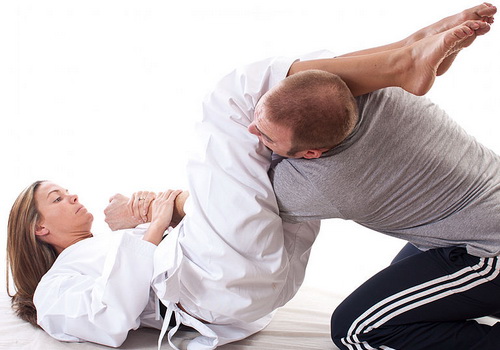
Judo - the 'Gentle Way' - Involves Throws, Locks and Ground Fighting
Judo is in some ways a good match for boxing. As boxers in the nineteenth century took the grappling out of striking, outlawing hitting and holding, tripping and 'foul moves,' Kano was going through his Jujutsu training and throwing out any technique that couldn't be practiced with full force against a resisting opponent safely. Consequently while Judo isn't especially destructive, it can be pressure tested - Judo players have thrown people who were trying not to be thrown. Belt grades are achieved by a Judo match; only the winner advances. Judo is practiced in a Gi similar to a Karate Gi but considerably thicker, to allow for gripping for throws.
- Important notification about information and brand names used in this slideshow!
- Photo courtesy of Scarface999 by Wikimedia Commons : en.wikipedia.org/wiki/File:Judo_Armbar.jpg
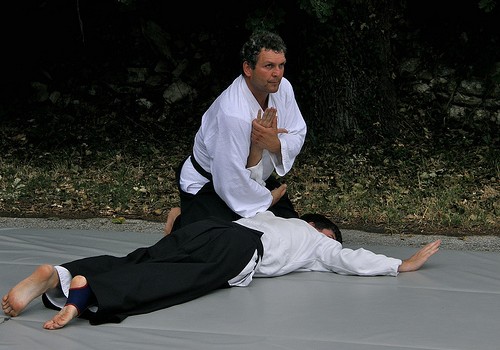
Aikido, the 'Way of Spiritual Harmony,' a Japanese Throwing Art
Aikido is another descendent of Japan's rich Jujutsu history. It consists in large part of throws from joint locks or partial locks; while there is some basic striking and Aikido's founder famously once said that '80% of Aikido is Atemi [hitting],' the art uses throws to injure opponents. If you have no Aikido training and are thrown successfully by an Aikido player (in the japanese arts, a player is a 'ka' - as in, Jodoka, Karateka, or Aikidoka) serious injury can result. However, Aikdio is often taught with an emphasis on its cultural traditions and a highly 'spiritual' attitude, and critics argue that this reduces its combat effectiveness.
- Important notification about information and brand names used in this slideshow!
- Photo courtesy of Darij & Ana by Flickr : www.flickr.com/photos/darij/3692973653/
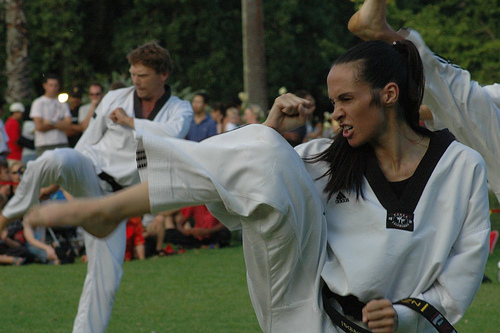
Taekwondo - Kicking System Made From Traditional Korean Systems and Karate
Taekwondo is a Korean martial art formulated by a Korean General, General Choi. At the lower levels it concentrates on fast, fluid kicks and basic hard blocks like those of Karate. There is some rudimentary throwing and grappling, but Taekwondo remains essentially a kicking art until the player reaches a very high level - black belt and beyond. Taekwondo's emphasis on high kicks gains it a reputation for ineffectiveness, since these are unwise movements to use in a street fight, but the system's self-defense syllabus also contains a more well-rounded collection of escapes, locks and even elbows and knees though these are not very well developed. Much of Taekwondo's appeal is as a sporting or competition system, and along with Judo it is an Olympic sport.
- Important notification about information and brand names used in this slideshow!
- Photo courtesy of Peter Harrison by Flickr : www.flickr.com/photos/devcentre/98495424/
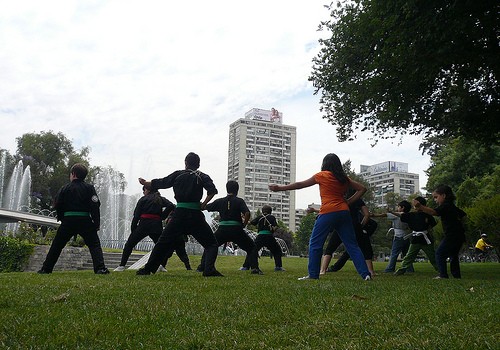
Ninjutsu - Are The Shadow Warriors For Real?
Ninjutsu means 'the way of endurance,' and the system trades heavily on its largely legendary or mythical history as a collection of covert assassination techniques dating from feudal japan. However, its secrecy and obscurantism have gained it a reputation as a 'LARPing' (for 'Live Action Role Playing') system - make believe, essentially. Much of the art is constructed from traditional Chinese systems, especially the northern crane system, and many Ninjutsu schools teach a wide range of weapons including swords, Sai (three-pronged daggers), tessen (small sticks that fit in the hand) and so forth. While some Ninjutsu schools emphasise endurance of suffering, others teach a 'pure' syllabus that sometimes involves training in masks and 'traditional Ninja' costume.
- Important notification about information and brand names used in this slideshow!
- Photo courtesy of Cristian Borquez by Flickr : www.flickr.com/photos/seo2/4213835627/
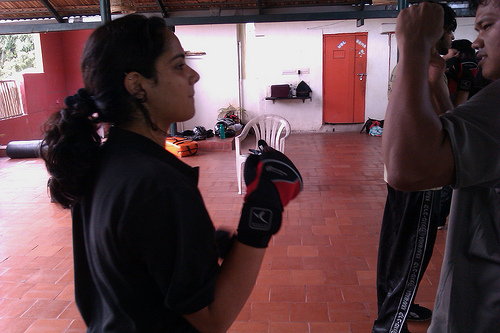
Krav Maga - Israeli Army Combatives Emphasizing Self Defense
Krav Maga is Hebrew for 'contact combat,' and the system originates with the Israeli military. Krav Maga is essentially a modern version of traditional Jujutsu - a last line of self defense for the disarmed soldier, concentrating on winning fights as quickly as possible by a combination of weapons retention or neutralization techniques and simple, aggressive movements that build on the actions that come naturally. This stands in contrast to many martial arts' emphasis on learning a whole new way of movement. Krav Maga is a good choice for those seeking a practical and simple method of self defense, though its lack of a 'spiritual' dimension or a train of cultural baggage makes some see it as unsatisfying and others question the authenticity of its military record.
- Important notification about information and brand names used in this slideshow!
- Photo courtesy of Frank Krav Maga Bangalore by Flickr : www.flickr.com/photos/frankjwolf/4986442196/
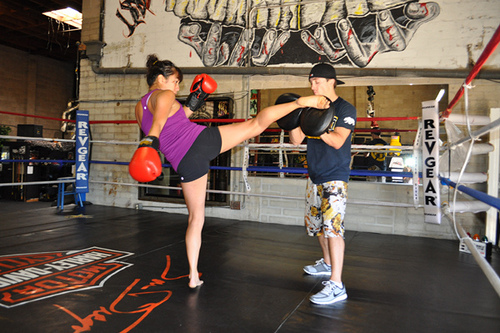
Muay Thai -The Science of Eight Limbs, Built for Power
Muay Thai means 'Thai fighting,' or 'Thai boxing.' Someone who does it is a 'nak muay,' and it is Thailand's national sport. In the early years of the 20th century Thai boxing underwent a change, being codified and losing many of its more complex techniques as well as many of its more dangerous techniques, to create a ring sport. The older techniques are still taught as a variety of systems under the broad heading 'Muay Boran ('ancient fighting'). Muay Thai is referred to as the 'science of eight limbs' since players learn to strike an opponent with legs, knees, fists and elbows. Kneeing and elbowing techniques are very highly developed in muay Thai.
- Important notification about information and brand names used in this slideshow!
- Photo courtesy of lululemon athletica by Flickr : www.flickr.com/photos/lululemonathletica/4666491669/
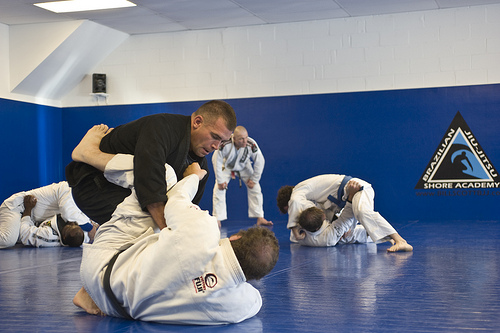
Jiu-jitsu and brazilian jiu-jitsu - Japan's Native Grappling Art and its Successful Offspring
Jujuts and Brazillian Jiu-jitsu share common ancestry but have evolved in strikingly different directions. In Japanese, 'jutsu' means 'method' or 'collection of techniques,' and Jujutsu means 'yielding methods' - the idea being that a player yields and adapts to his opponent in order to overcome him. The origin of the idea becomes obvious when you consider that Jujutsu began as the last line of self-defense for the disarmed battlefield warrior in the days of the sword. While Japanese Jujutsu covers a wide range of schools teaching a broad selection of techniques, we can generalise: Jujutsu was originally designed for killing people, which means it contains many techniques which cannot be trained with any force against resisting opponents. As a result it is largely taught by 'two-person kata' - stylised combat exchanges whose value was notably criticised by Kano, the founder of Judo. Jujutsu seeks to provide players with a practical body of self defense techniques including hitting, kicking, throwing, grappling and weapons. Brazillian Jiu-jitsu is the brainchild of Helio Gracie, and was popularised by another Gracie, Royce, who brought the system to the world's attention by dominating the early UFC (Ultimate Fighting Competition) events, using basic striking and movement skills...
Jujuts and Brazillian Jiu-jitsu share common ancestry but have evolved in strikingly different directions. In Japanese, 'jutsu' means 'method' or 'collection of techniques,' and Jujutsu means 'yielding methods' - the idea being that a player yields and adapts to his opponent in order to overcome him. The origin of the idea becomes obvious when you consider that Jujutsu began as the last line of self-defense for the disarmed battlefield warrior in the days of the sword. While Japanese Jujutsu covers a wide range of schools teaching a broad selection of techniques, we can generalise: Jujutsu was originally designed for killing people, which means it contains many techniques which cannot be trained with any force against resisting opponents. As a result it is largely taught by 'two-person kata' - stylised combat exchanges whose value was notably criticised by Kano, the founder of Judo. Jujutsu seeks to provide players with a practical body of self defense techniques including hitting, kicking, throwing, grappling and weapons. Brazillian Jiu-jitsu is the brainchild of Helio Gracie, and was popularised by another Gracie, Royce, who brought the system to the world's attention by dominating the early UFC (Ultimate Fighting Competition) events, using basic striking and movement skills to gain a position where he could take an opponent to the floor and use BJJ's highly-developed ground grappling to force a submission by choking or joint locking. BJJ is trained by 'rolling' - live, competitive groundfighting training. While this sees the system criticised as a self defense method, as fighting a single opponent on the ground is unsafe in many combat situations, the art contains a self-defense syllabus and some BJJ schools teach a combat version of the art while others concentrate on competition, or MMA-applicable techniques.
- Important notification about information and brand names used in this slideshow!
- Photo courtesy of U.S. Coast Guard by Flickr : www.flickr.com/photos/coast_guard/7748736858/
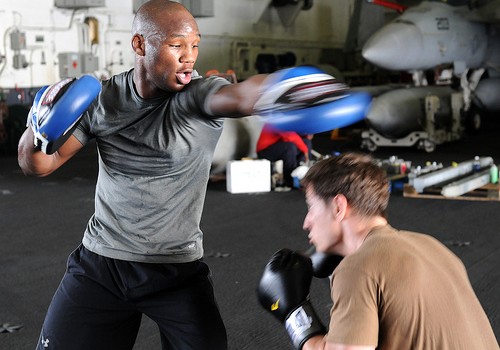
Boxing, the Noble Art of Self Defense, Remains a Winner
Boxing grew out of native European unarmed combat and was codified from the 1700s to the twentieth century. At one time boxing was done bare knuckle for unlimited rounds, and fights of 100 rounds were not unheard of, between fighters who could reputedly punch the bark off trees; by the twentieth century boxing was tightly codified with no striking below the belt, no holding to hit, no kicking, tripping or sweeping and no grappling. While its range of techniques is narrowly prescribed boxing can be a highly effective system and there is no better way to knock somebody out with your fists.
- Important notification about information and brand names used in this slideshow!
- Photo courtesy of Official U.S. Navy Page by Flickr : www.flickr.com/photos/usnavy/5974363898/



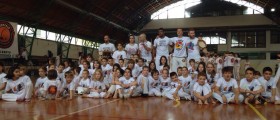











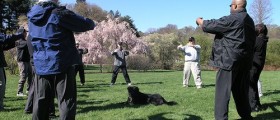











Your thoughts on this
Loading...